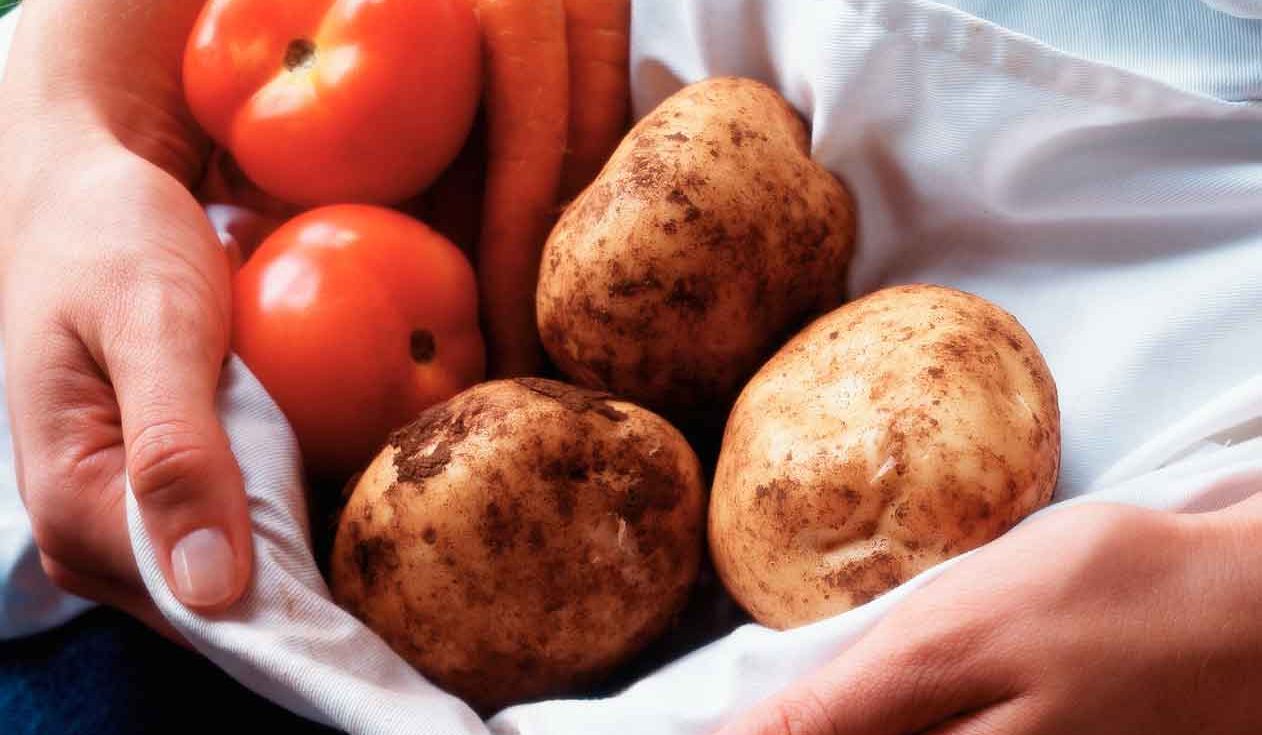Americans’ Vegetable Choices Are Mostly Potatoes and Tomatoes

More variety would be better for your health, but potatoes and tomatoes have plenty of nutritional value.
If you’re like most Americans, your vegetable intake is mostly potatoes and tomatoes. With lettuce, they comprise 59 percent of the vegetables grown for and distributed to Americans annually.
White potatoes accounted for 30 percent of the 384.4 pounds per person of vegetables and legumes available in 2013, according to a U.S. Department of Agriculture (USDA) report. Tomatoes had a 22-percent share, with 20.2 pounds per person of fresh tomatoes and 65.9 pounds per person of processed tomatoes.
Fresh lettuce (head lettuce, romaine, and leaf lettuce) rounded out the top 3 vegetables at 25.5 pounds per person — 7 percent of 2013’s total vegetable and legume availability.
YOU MIGHT ALSO LIKE: Why Don’t Americans Eat More Fruits and Vegetables?
The problem isn’t that you eat so many potatoes and tomatoes. It’s that you don’t eat more of a variety of vegetables. You would get more needed nutrients.
The USDA Economic Research Service (ERS) report also notes that demand drives supply, so the limited vegetable consumption holds back the growth and distribution of other vegetables as well.
“Even though vegetable consumption is more diverse than it was 40 years ago, many Americans keep coming back to the same few favorites,” says the ERS newsletter Amber Waves. “Restricting one’s diet to a limited set of vegetables precludes the desired variety that would supply more diverse, healthful nutrients.”
The USDA Food Availability Data System tracks annual national and per capita supplies for over 40 vegetables and legumes, so there’s plenty of variety out there.
Amber Waves notes that dark greens, such as spinach or kale, are rich in vitamin A and folate, while legumes (dry beans and peas, kidney beans, split peas, and lentils) are good sources of protein and fiber. A variety of vegetables also provide many phytochemicals, or antioxidants, believed to be important in fighting cell mutation that can lead to cancer.
Besides that lack of variety, the USDA notes that all those potatoes and tomatoes you consume are contained in forms such as potato chips, French fries, and tomato sauces such as ketchup.
A registered dietitian and nutrition author, though, cautions you not to get too caught up in what the survey implies.
“In terms of the U.S. diet and issues with it, potatoes and tomatoes are the least of our problems,” says Bonnie Taub-Dix, MA, RDN, a practicing dietitian, columnist, and the author of “Read it Before You Eat It.”
“One potato has twice the amount of potassium compared to a banana, and they are loaded with fiber and satiating carbs that keep you from eating other foods higher in calories. I encourage people to eat them.”
She adds that potatoes have a lot to do with the company they keep on your plate. Generally speaking, if you’re eating a baked potato, she says, you also have other vegetables on your plate.
Tomatoes are very high in vitamin C, contain fiber, and have antioxidants including lycopene (the reason for the color). Given that, Taub-Dix says she’d be “thrilled” if you were eating more potatoes and tomatoes. She adds that whole potatoes and tomatoes are great foundations for dishes, such as veggie casseroles or stews, that can include other vegetables.
Another dietitian says the survey finding is consistent with the “last several” such surveys, and it’s not surprising because “people love their French fries and potato chips, and tomatoes count for anything Italian with spaghetti sauce, in salsa.”
“That’s why the consumption is so large,” says Sarah Krieger, RDN, a spokesperson for the Academy of Nutrition and Dietetics.
Krieger, who works with many children, pregnant women, and whole families, would love to see you eat more raw tomatoes on your salad, but also realizes that many people are going to pick them off. “But salsa, you’ll eat it all day long.”
“I try to get people to understand that everything we eat has different nutrients, so if you overeat one or two foods, you’re just missing out on vitamin A or beta-carotene, for instance.”
She suggests buying what’s in season in your area, such as pumpkins and squash in the fall, and buying it locally grown. They will be fresher and the prices will be rock bottom.
You should also think of buying something different every time you go to the grocery store. Try some radishes, for example, or some “weird fruit” that so many stores carry now. There are “thousands” of ways to prepare eggplant, Krieger says, and your kids may not even know they’re eating it.
“It keeps you from getting bored. I try to shake it up with my family so we don’t get used to eating the same things,” she says. “You don’t want to force it down (your kids’) throat. Everybody likes different vegetables and likes them prepared different ways.”
So, while you shouldn’t deliberately try to disguise vegetables so your family will eat them, you should collect a wide variety of recipes and learn as many ways to prepare them as possible, Krieger adds.
Updated:
April 09, 2020
Reviewed By:
Janet O’Dell, RN